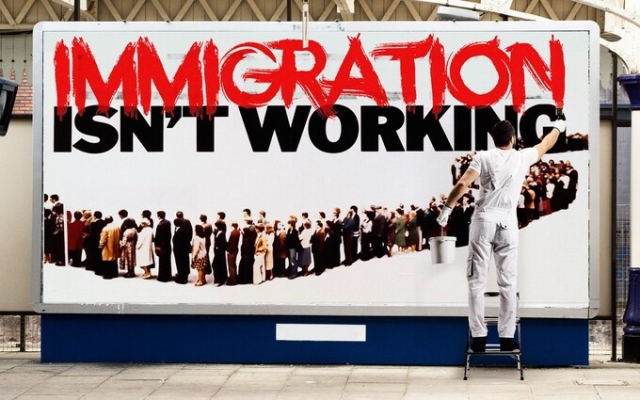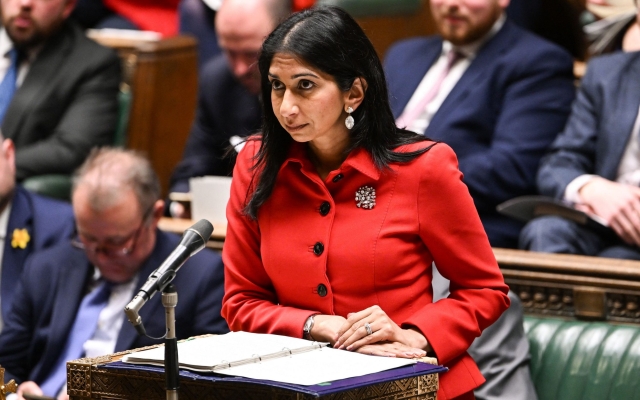 Figures published by the Office for National Statistics last week showed that net migration reached a record level last year
Figures published by the Office for National Statistics last week showed that net migration reached a record level last year
Sir Keir Starmer becomes lucky general. Whenever the Tory gloom briefly lifts and Rishi Sunak prepares to bask in a rare ray of good news, it is almost immediately overshadowed by new problems.
Earlier this month, for example, new data showed that inflation had fallen. fell more sharply than expected. But hours later it was overshadowed by the Supreme Court thwarting the government's plan to try asylum seekers in Rwanda.
Then, the week before last, Jeremy Hunt had barely sat down after delivering a morale boost to National Insurance as the denouement of his autumn statement before the Office for National Statistics (ONS) appeared and announced the arrival of a record number of migrants. in the UK last year.
It has not escaped the attention of many in Westminster that these two pieces of bad news for the Tories are linked. Starmer has certainly identified immigration as the topic most likely to inspire the Conservative Party to form a firing squad, and he duly doled out the ammunition from the drop box at Wednesday's Prime Minister's Questions. Sunak promised, as the Labor leader noted, to cut taxes. However, the overall burden continues to grow. He also promised to cut NHS waiting lists. But they are also moving in the wrong direction. It was the same story (and even more) with immigration.
Starmer helpfully reminded MPs of claims by Suella Braverman, the former home secretary, that the prime minister had abandoned his agreement with her to introduce tougher immigration measures in exchange for her support for the 2022 Conservative leadership contest. He also referred to comments made the previous day by Robert Jenrick, the immigration minister, who expressed disappointment that stronger immigration reforms had not been introduced last year.
«The Immigration Minister thinks the Prime Minister is failing because apparently no one will listen to his secret plan, the former Home Secretary thinks he is failing because of his 'magical thinking', the current Home Secretary [James Cleverley] thinks he is failing,” Starmer said. “The Prime Minister appears to be the only person on the Tory benches who does not have his own personal immigration plan.”
 Suella Braverman , the former Home Secretary, makes a statement on the Illegal Migration Bill in March. Photo: ANDY BAILEY/AFP
Suella Braverman , the former Home Secretary, makes a statement on the Illegal Migration Bill in March. Photo: ANDY BAILEY/AFP
While getting the economy out of the way, getting the NHS fit for purpose and getting re-elected are the biggest challenges facing the government (and not necessarily in that order), immigration may be the toughest nut to crack. That's because, whether politicians want to admit it or not, the country currently relies on a constant flow of foreign workers into the country to help generate modest economic growth and staff the NHS. So can this country break its addiction to immigrant labor?
The Tories' path to ruin
If the UK slams its doors tomorrow, both the economy and healthcare will undoubtedly suffer. The UK is by no means the only country facing this problem: the foreign population in the world's rich countries is growing faster than at any time in history. However, a failure to face demographic realities or make the compromises needed to tackle high levels of immigration has seen the Conservative Party paint itself into a corner.
Data published by the ONS last week showed that net migration (the number of people arriving in the UK minus those leaving) hit a record high of 745,000 last year, a full 159,000 more than previously estimated. Between the middle of last year and the middle of this year, the UK population grew at its fastest rate for more than 60 years.
Ms Braverman called the latest figures “a slap in the face of the British public, who have voted to control and reduce immigration at every opportunity.” Sunak is under pressure from a faction of MPs concerned that the party's right flank is vulnerable to the UK Reform Party. They said reducing net migration was a do-or-die matter before the next election.
The former Home Secretary is right to point out that voters were promised both border control and immigration cuts on multiple occasions. David Cameron famously promised to cut net migration by up to «tens of thousands» during his premiership, and the Conservatives have promised to cut migration in each of their four election manifestos since 2010.
One of the promises of Brexiteers was that it would give Britain control of its borders. Ahead of the 2019 election, the Tories said the number of people entering the country would be below the then annual level of 226,000. Instead, that figure tripled.
Sunak noted on Thursday that he had «inherited» a «very large amount» of legal migration — a not-so-subtle rebuke of his predecessor Boris Johnson. But Tory supporters are whispering loudly that they have not yet seen Sunak's own plans for legal migration or promised emergency legislation to revive the Rwandan scheme.
Earlier this week YouGov's Dr Alan Wager noted that «Politics «Immigration has changed» — in other words, the issue has gone from being the Conservative Party's «ace card» to being a stick with which Starmer can defeat them.
One of the most open modes in the world
How did Tori turn strength into a potentially fatal flaw? The answer to this question lies in who is allowed into the country and why.
First, it is important to distinguish between legal migration and asylum seekers. Those arriving in the UK on small boats crossing the English Channel and other secret routes have attracted a lot of attention. However, their numbers are small compared to the total number of foreigners coming to the UK each year. The vast majority of immigrants are students, health professionals and skilled workers, and all are welcome.
Of the 1.2 million people who arrived in the UK in the 12 months to June this year with plans to stay, more than a million were not EU citizens. About 40% of this group — by far the largest proportion — came to the UK to study. According to the ONS, the main reason for the increase in arrivals from outside the EU was those traveling for work, particularly in the health and care sectors, and bringing their dependents with them.
Numbers may vary. peaks as the backlog from the Covid-19 pandemic clears and overseas hiring of skilled labor slows amid a weakening labor market. According to various estimates, net migration will fall to around 400,000 next year and eventually total around 250,000 per year.
Ask most leading economists how the UK could reduce immigration below this level and they will tell you why the government would want to do so. The Office for Budget Responsibility (OBR) has previously said legal migration is helping to offset slowing productivity growth. Last November, Chancellor Jeremy Hunt said it was «very important» for the British economy.
The latest strong immigration figures were described as «encouraging» by Paul Dales, chief economist at Capital Economics, as the UK suffers from a post-pandemic labor shortage that is «holding back economic growth and adding to inflation».
In its recent assessment of the UK economy, the OBR said gross domestic product would grow by just 0.6% this year. But if you calculate GDP per capita, you get a decrease of 0.3%. In other words: without high levels of immigration into the country over the past year, the economy will shrink. Indeed, the Organization for Economic Co-operation and Development (OECD) estimates that immigration accounted for at least half of UK economic growth between 2005 and 2015. But she is concerned that net immigration will fall to just over 100,000 a year after Brexit. The OBR has long made similar assumptions in its forecasts for the UK economy.
In its report, The Economic Impact of Brexit, the OECD concluded that much of the damage caused by Britain's departure from the European Union would result from subsequent restrictions on migration, leading to «fewer skilled workers» and a decline in «technological progress.»
But instead of declining, immigration has actually increased dramatically. Free movement is over. Great Britain regained control of its borders. And, ironically, Johnson took the opportunity to create what Professor Jonathan Portes of King's College, an expert on the economics of migration, calls one of the most open work visa regimes in the world.  Net migration has risen sharply during Boris Johnson's time in office. Photo: Getty Wrong height
Net migration has risen sharply during Boris Johnson's time in office. Photo: Getty Wrong height
Migration stimulates the economy by increasing the labor force. However, it is less clear whether this increases productivity, resulting in growth that improves living standards. Some argue that high levels of immigration may actually block productivity as businesses become dependent on cheap labor and therefore have less incentive to invest in technology and training (although the evidence for this is weak).
However, high levels of immigration can clearly lead to some distortions. “Overall, the impact [of migration] on the labor market is relatively small, with little impact on average wages,” Professor Portes wrote last year. “However, research suggests that migration may have a relatively small effect on lowering wages for low-wage workers.”
It was for this reason that the UK government introduced a new points system, which issued visas to workers with a salary and educational level above a certain level. Subsequently, the annual intake of migrants has shifted from low paid and less skilled EU workers to higher paid and more skilled non-EU migrants. Visas are also available for some skilled occupations paying less than £26,000 (such as service providers) if they are on the government's list of occupations with labor shortages.
Two thirds of UK employment growth since 2010 and 80% since Brexit is the result of migration. Foreign health workers are plugging numerous holes in the NHS workforce, and international students have turned higher education into one of the country's export industries (worth an estimated £29 billion a year). So the system as a whole is working as intended, even if the government has not been entirely clear about those intentions.
None of this can entirely allay widespread fears that high levels of immigration are stretching the social fabric of the country and puts a strain on infrastructure and government services. This includes, for example, clear evidence that the influx of foreign workers into London is increasing pressure to increase rents in the capital.
However, the end of free movement appears to have led to a public understanding that the benefits and drawbacks of high immigration are becoming increasingly nuanced, according to opinion polls.
(Un)popular migration
The YouGov tracker poll shows 60% of voters think immigration is too high, up slightly from 57% before the last election. But ask them whether the country should allow more foreign doctors, nurses, medical workers, students, scientists and even fruit pickers to live here, and those surveyed will raise flags and roll out the welcome mat.
Voters are also extremely pleased that Britain is accepting more refugees from Ukraine, Hong Kong and Afghanistan. It is difficult to avoid the somewhat paradoxical conclusion that the British are generally dissatisfied with high levels of immigration, but are very relaxed about the arrival of immigrants.
This is part of a long-term attitude change. Over the last decade, the holy trinity of political issues among voters has consistently been the economy, health and immigration (except for the four years after the Brexit referendum, when leaving the EU trumped all other issues).
Immigration was the top issue in the lead-up to the referendum, with 71% of those surveyed citing it as one of the country's top three problems. By comparison, 35% chose economics and 28% chose health. Unsurprisingly, this list has been turned on its head during Covid-19, with the majority of people choosing health during and immediately after the pandemic, while the economy has become the top concern over the past couple of years.
Recent polls show That 55% of voters named the economy as one of the country's top problems, while 44% chose health care and only 38% named immigration. According to Professor Rob Ford of the University of Manchester, this is consistent with much longer-term data showing support for immigration restrictions is falling.
A study of polls shows that despite (or perhaps because of) migration reaching record levels, more Britons than ever before believe migration beneficial from both an economic and cultural point of view. Moreover, concerns about immigration are overwhelmingly concentrated among Conservative voters.
The picture that emerges from all this is one of a huge quandary for Sunak. Failure to address high immigration could well punish Conservatives among their own voters; but harsh measures may not help them find the new ones they need. In addition, fulfilling the party's promise to reduce immigration would likely result in a blow to two issues — the economy and health care — that voters consider more important. This is completely funny.
The solution to the immigration growth trap
How can a politician try to get out of such an enviable position? Short answer: with difficulty (especially for the next general election).
The longer answer is that immigration has become the political equivalent of duct tape that an incompetent handyman uses to make so many “temporary” fixes that it is now the only thing keeping the house afloat. If you want to rip the tape, you first need to solve a lot of structural problems in the economy and government services that no one has had the time, money, inclination or imagination to fix. There is, of course, no silver bullet.
Given that the largest cohort of immigrants each year are students, this seems the most obvious starting point. Indeed, the UK government has already done this. From January this year, international students will no longer be able to bring their families with them unless they are taking courses designated as research programmes. A loophole allowing immigrants to exchange a student for a work visa before completing their studies has also been closed.
However, a larger drop in the number of international students will almost certainly have to be accompanied by a new approach to university funding. Higher education institutions rely heavily on tuition fees, but the cap has not been increased since 2017, resulting in a significant real reduction in terms when inflation is taken into account.
According to the Russell Group, English universities now add an average of £2,500 to each UK student's tuition fees. By the end of the decade, this deficit will increase to an average of £5,000 per student per year. To close this gap, universities are accepting more international students, from whom they can charge what they want (or get away with it).
International students now make up about a fifth of university revenue, double that figure. proportion ten years ago. Earlier this year, Vivien Stern, chief executive of Universities UK, told the Lords committee that tuition fees paid by international students «should be the icing on the cake» of higher education funding. Instead, they are «more like flour.»
At the same time, the government will also have to find money to train more doctors and nurses. Around 14% of all UK residents were born overseas. However, 34% of doctors, 28% of nurses and 19% of all NHS staff are immigrants.
Earlier this year, the NHS announced a long-term workforce plan that will see the number of medical school places increase from 7,500 to 15,000 by 2031. The number of nurse training places will also increase by a third to 40,000 by 2028. However, training doctors is expensive. That's why universities turned down 10,000 medical school applicants last year despite achieving the required grades. Increasing the number of medical training places available to UK students by just 1,500 per year would cost around £427 million. Perhaps that's why last year foreign nationals made up 46% of all doctors joining England's NHS in 2022, out of a total of 12,148.
Reversing the benefits boom
Addressing labor shortages in the broader economy will likely require a similar Sisyphean effort. But at least politicians know where to look. The number of working-age people considered “economically inactive” has risen sharply in recent years. The official unemployment rate may have fallen this week to a low not seen since the 1970s, but the number of those not working or looking for work — often because they are caring for themselves or sick — has risen sharply. In some of the country's biggest cities, such as Birmingham and Liverpool, a quarter of all working age adults are unemployed and not trying to find one.
Reverse this trend, provide retraining and encourage more people to rejoin the workforce. and the economy will be less dependent on skilled foreign-born workers. The number of new arrivals in the UK is settling at a rate of 3,000 a day, and the number of people claiming sick pay recently reached 4,000 a day.
Part of the solution could be to reduce waiting times and improve the NHS's ability to deal with chronic diseases, which are partly responsible for the unemployment trend. However, three quarters of long-term patients do not wait for treatment. Indeed, the biggest increase is among people under 35, many of whom complain of bad nerves rather than a wobbly hip. The £300 billion welfare bill easily dwarfs the NHS budget, and the disability benefits bill is forecast to reach almost £30 billion in less than five years — double what it was just a decade ago.
Mel Stride, the work and pensions secretary, also recently announced reforms to help those with health problems who want to work «with the right support and opportunities to move off benefits and into the labor market». However, he told the House of Commons that one in five people considered too ill to work want a job, suggesting much more radical and politically challenging measures may be needed to rein in Britain's runaway welfare system: tougher assessments ability to work, perhaps then ending subsidized travel, preferential broadband and telephone schemes and even, eventually, Universal Credit itself for those who refuse to work.
There is another domestic remedy. With the UK's natural population likely to peak in the next year or two and begin to decline in the second half of the decade, the best hope for accelerating growth in the absence of an influx of foreign workers will be to stimulate a higher birth rate. tax breaks, cheaper child care and, above all, more affordable housing) and increase productivity.
This will be much easier said than done. Economists have created scalp sores by scratching their heads trying to solve the UK's «productivity puzzle». Most agree that increasing business investment is key. Tax breaks and other incentives could help.
But many companies privately admit they have been sitting on their hands and waiting for a period of political calm after the turmoil of recent years. It may be helpful to briefly stop policies that promise one thing and do the opposite.






















































Свежие комментарии